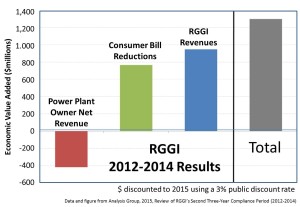RGGI Lookin’ Good
Posted: July 14, 2015
The Regional Greenhouse Gas Initiative (RGGI) of nine northeastern states has been a boon to the nine member states’ economies while CO2 emissions from power plants have dropped by about 18%, according to a report released today.
How much of the emissions reductions was actually due to the cap is arguable. The original cap was far above the actual emissions and has since been modified downward.
The RGGI – a cap and trade program for power plants – has been in place for over six years. It has added about $1 billion in revenues to the region in the two three year periods analyzed (2009-2011) and (2012-2014), or a total of about $2 billion. But the boon to the economy is greater than that. The report estimates that the second three-year period generated $1.3 billion in net economic benefits across the region (in 2015 dollars), on top of that from the first three years (2009-2011) of $1.6 billion of economic value added (in 2011 dollars).
The extra benefit is primarily from savings generated by investments in energy efficiency programs that reduce energy consumption in the electricity sector, and investments in renewable projects that have low operating cost.  Both lower the amount paid out for energy, and offset the increased electricity prices resulting from the cost of RGGI allowances.
Both lower the amount paid out for energy, and offset the increased electricity prices resulting from the cost of RGGI allowances.
Power plant owners recover the costs of CO2 in the short run but see lower demand in the long run, thus dropping their revenues. Thus plants with lower CO2 emissions get a competitive advantage. The net of these competing forces is shown in the figure.
In terms of GDP (or Gross State Product) in the past six years the region has performed on a par with the rest of the U.S. The largest economy in the RGGI – New York – actually did better than the U.S. overall.
The RGGI could be a model for how other states approach U.S. EPA’s Clean Power Plan. It could also be expanded to include other emissions such as from other industries and transportation.
RGGI also shows the success of a regional approach. The auction system is centralized, and according to the report, working well. But the individual states can decide how to spend their share of the revenues, retaining autonomy.

No one has left a comment yet.